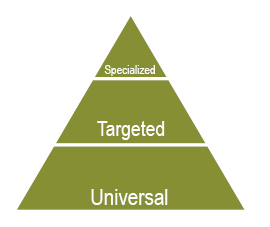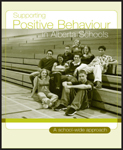 |
Universal Supports benefit all students
-
Work collaboratively with school staff to ensure that there is a school-wide commitment that all school assemblies are organized to maximize student engagement and have:
- clear goals and purposes
- structures and activities that are engaging and meaningful to all students
- reasonable timelines (e.g., start and finish on time, less than one hour in duration).
- Communicate clear expectations about behaviour and participation during school assemblies.
- Develop effective routines that will support positive behaviour and participation during school assemblies, such as:
- preview of goals and program schedule with students prior to assemblies
- class and student seating plans
- plans for active supervision.
- Make instructional time available to teach, practise and review routines with students at beginning of school year, including walking to and from the gym, signals for silence and seating arrangements.
- Preview the purpose and program for each upcoming assembly with students so they have a general idea of what to expect.
- Post visual reminders for behaviour expectations in the learning space where the assembly will take place and in the classroom. Review reminders before going to the space. When appropriate, collaborate with students to develop these visual reminders.
- Use descriptive feedback to acknowledge positive behaviour demonstrated by individuals, groups of students and/or the class as a whole.
|
|

|
Targeted Supports benefit students with more specific needs
- Pair individual students with positive peers who can serve as role models and offer support during assemblies.
- Provide proximity by positioning yourself nearby individual students who may require support during the assembly.
- For students who require more structure and reassurance, develop and review social stories about what will typically happen in an assembly.
- Use a Check Out/Check In strategy for students to check in with a school staff member before the assembly to commit to following one or more rules, and to check in after the assembly to report on how the assembly went.
- If students have difficulty with attention, encourage them to bring an unobtrusive fidget toy or object with them.
- Work with individual students to develop self-monitoring strategies they can use to reflect on and keep track of their own behaviour in assemblies.
- Set up systematic reinforcement strategies for students who are working on improving and maintaining behaviour in assemblies (e.g., one-incident free assembly earns access to the classroom computer during that lunchtime). Reinforcement should encourage moving toward intrinsic motivation (e.g., "How does it feel when you …?").
|
 |
Specialized Supports benefit the small number of students with sensory, physical, cognitive or behavioural needs that require intensive, individualized interventions
- For students with intense sensitivities to sound, explore the use of
sound-muffling ear plugs that would minimize noise (e.g., loud music,
cheering) during activities.
- For physical safety, individual students may need 1:1 adult support to ensure they travel safely to the assembly and to facilitate social interactions with other students and school staff. This support should be provided as unobtrusively as possible, and, when possible, students should travel at the same time as other students and be seated with the class.
- Consider a limited-time participation for students who experience intense agitation or anxiety during an assembly. They may benefit from participating in the assembly for a short time (e.g., five minutes) and then gradually increasing the time at each assembly throughout the school year.
|






